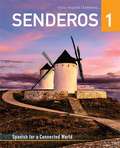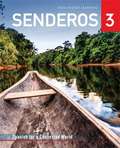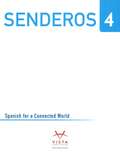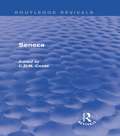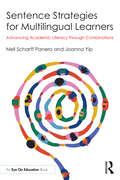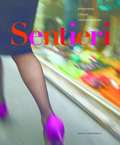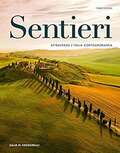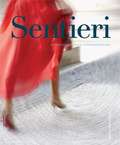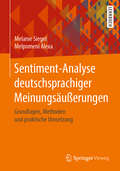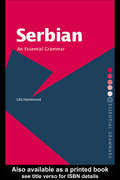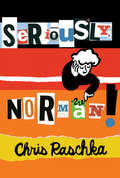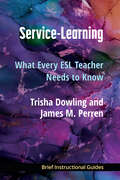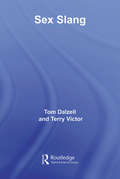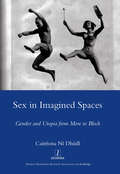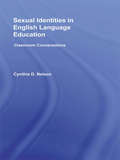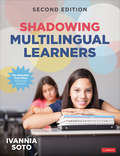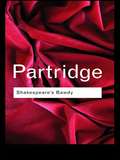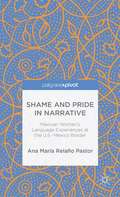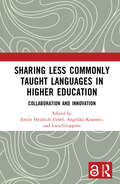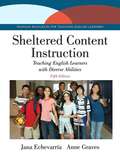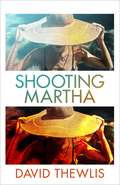- Table View
- List View
Sendas literarias 1
by Aída Walqui-Van Lier Ruth A. Barraza Mary Ann DellingerThis highly praised two-level literature and language series taps the natural potential of heritage learners, building their listening, speaking, reading, and writing skills as it celebrates and validates their rich cultural heritage. The varied learning strategies, study skills, and activities are specifically designed to meet the diverse needs and ability levels of native Spanish speakers.
Senderos Level 4 Spanish for a Connected World
by Vista Higher LearningSenderos Level 4 Spanish for a Connected World
Seneca (Routledge Revivals)
by Costa C.D.N.This volume, first published in 1974, offers a selection of modern perspectives on Seneca, covering his prose treatises, his letters and his tragedies. For centuries literary and philosophical circles had to take Seneca seriously, even if they could not always respect him, and although his reputation has fluctuated, there has been a revival of interest in his achievements. Accordingly, a large part of Seneca is devoted to this later influence at the deliberate expense of not covering all of Seneca’s less familiar works. The Moral Essays, the tragedies and the letters to Lucilius are examined by the contributors, who also discuss Seneca’s philosophical influence and the Senecan heritage in English and neo-Latin literature. Each essay contains insightful and sometimes controversial material, which is of value to the specialist as well as to students of Latin, English or French literature.
Sentence Strategies for Multilingual Learners: Advancing Academic Literacy through Combinations
by Nell Scharff Panero Joanna YipThis book presents Combinations as a set of high-yield instructional strategies for advancing academic literacy for multilingual learners and all students. It discusses the strategies themselves as well as how they work to advance content and language learning simultaneously, across the grades and content areas. The book is particularly beneficial for all teachers working with linguistically and culturally diverse learners to accelerate their language and content learning. Utilizing these strategies will not only greatly improve students’ writing but also supports their critical thinking, content area reading and language comprehension skills. This book argues for utilizing Combinations with Strategic Inquiry, presenting evidence of how each amplifies the impact of the other, and how together they address many of the challenges to learning new and counter-cultural methods and to establishing school and district cultures in support of multilingual learners’ success. This book is a great resource for classroom teachers, literacy coaches and school and district administrators who want to support multilingual learners and all students to thrive.
Sentence Strategies for Multilingual Learners: Advancing Academic Literacy through Combinations
by Nell Scharff Panero Joanna YipThis book presents Combinations as a set of high-yield instructional strategies for advancing academic literacy for multilingual learners and all students. It discusses the strategies themselves as well as how they work to advance content and language learning simultaneously, across the grades and content areas.The book is particularly beneficial for all teachers working with linguistically and culturally diverse learners to accelerate their language and content learning. Utilizing these strategies will not only greatly improve students’ writing but also supports their critical thinking, content area reading and language comprehension skills. This book argues for utilizing Combinations with Strategic Inquiry, presenting evidence of how each amplifies the impact of the other, and how together they address many of the challenges to learning new and counter-cultural methods and to establishing school and district cultures in support of multilingual learners’ success.This book is a great resource for classroom teachers, literacy coaches and school and district administrators who want to support multilingual learners and all students to thrive.
Sentiment-Analyse deutschsprachiger Meinungsäußerungen: Grundlagen, Methoden und praktische Umsetzung
by Melanie Siegel Melpomeni AlexaDer Zugang zu Information ist durch das Internet erheblich verändert und erleichtert worden. Gleichzeitig gibt es seit dem Web 2.0 die Möglichkeit für alle Internet-Nutzer, selbst Inhalte beizusteuern, indem sie in Foren schreiben, oder Twitter, Xing, LinkedIn, Facebook oder andere soziale Medien nutzen und auf veröffentliche Posts z. B. durch Kommentare reagieren. Diese Fülle an Informationen und Meinungen ist ein wertvoller und in der Regel sehr großer Datenschatz, den man nur mit automatischen Verfahren sinnvoll nutzen kann.Die automatische Analyse von Meinungsäußerungen gehört in die Anwendungsbereiche Informationsextraktion und Inhaltsanalyse sowie Text Mining. Aus Texten von Internet-Nutzern werden Informationen extrahiert und analysiert, wie sie sich zu bestimmten Themen, Produkten oder Ereignissen äußern.Dieses Buch gibt eine systematische Einführung in Methoden der automatischen Analyse von Meinungsäußerungen und zeigt die Anwendung der beschriebenen Methoden in Programmierübungen. Der Fokus liegt dabei auf deutschsprachige Daten, also auf linguistischen Ressourcen sowie Methoden zur automatischen Analyse für die deutsche Sprache. Viele Übungsaufgaben sowie in Python implementierte Programmierbeispiele und -aufgaben machen das Buch zum optimalen Begleiter für Studium und Selbststudium.
Serbian: An Essential Grammar (Routledge Essential Grammars)
by Lila HammondSerbian: An Essential Grammar is an up-to-date and practical reference guide to the most important aspects of Serbian as used by contemporary native speakers of the language. Refreshingly jargon free, it presents an accessible description of the language, focusing on the real patterns of use today. A reference source for the learner and user of Serbian irrespective of level, it sets out the complexities of the language in short, readable sections. Features of this Grammar include: * use of Cyrillic and Latin script examples throughout* a cultural section on the language and its dialects* clear and detailed explanations of simple and complex grammatical concepts* detailed contents list and index for easy reference. Well-presented and easy to use, Serbian: An Essential Grammar is ideal either for independent study or for students in schools, colleges, universities and adult education.
Seriously, Norman!
by Chris RaschkaCaldecott Medalist Chris Raschka makes his dazzling debut as a fiction writer Now that the whole thing is over (and we all survived!), I can tell you what happened. Picture this for a second. Rock wall six inches on my left. Sheer cliff hundreds of feet down on my right, my best friend Norman in front of me, mumbling something, and my mom behind me saying, "Step, step, step." EEEEEEYAAAAAH! Next time my mom bugs me about sitting in front of the computer too much, I'm going to say, "Thanks, I prefer it where the near-death experiences are virtual!" No, seriously, this story is about Norman and about how he grows and learns stuff. Uses his imagination. Observes things. Like his dad, who is so devoted to . . . money! Like how his dad is mixed up with weird creeps of the underworld. All over the world! Why, why are grown-ups so insane? That's exactly the question that Norman, Anna and Emma (the twins), and I, Leonard, try to answer. And with the help of Norman's new tutor, Balthazar Birdsong (also fairly nuts), we nearly do it, too.
Service-Learning: What Every ESL Teacher Needs to Know
by James Perren Trisha DowlingService-Learning: What Every ESL Teacher Needs to Know gives practical information on implementing service-learning in the field of TESOL. Service-learning—"the accomplishment of tasks that meet genuine human needs in combination with conscious educational growth"—has developed into a pedagogical approach that incorporates student learning and reflection with curricular concepts while partnering with community organizations. Following an overview of service-learning in the field of TESOL, this text includes sections on incorporating service-learning in an ESL course, finding appropriate community partnerships, making decisions about culture- and language-based lessons, assessing students, and making the experience meaningful. Also included are four specific strategies to help readers make the case for service-learning to administrators.
Sex Slang
by Tom Dalzell Terry VictorAre you a beaver cleaver or the office bike? Would you rather pack fudge or munch carpet? Do you content yourself with paddling the pickle as you’re still a cherry boy? Sex Slang will not only give you 3,000 words to talk about your favourite pastimes, but also open your eyes to practices you didn’t even know existed. All words are illustrated by a reference from a variety of sources to prove their existence. This naughty book will give you a spectacular sexual vocabulary from all over the English speaking world, as well as hours of reading pleasure.
Sex in Imagined Spaces: Gender and Utopia from More to Bloch
by Caitriona DhuillFrom Thomas More onwards, writers of utopias have constructed alternative models of society as a way of commenting critically on existing social orders. In the utopian alternative, the sex-gender system of the contemporary society may be either reproduced or radically re-organised. Reading utopian writing as a dialogue between reality and possibility, this study examines the relationship between historical sex-gender systems and those envisioned by utopian texts. Surveying a broad range of utopian writing from the nineteenth and twentieth centuries, including Huxley, Zamyatin, Wedekind, Hauptmann, and Charlotte Perkins Gilman, this book reveals the variety and complexity of approaches to re-arranging gender, and locates these 're-arrangements' within contemporary debates on sex and reproduction, masculinity and femininity, desire, taboo and family structure. These issues occupy a position of central importance in the dialogue between utopian imagination and anti-utopian thought which culminates in the great dystopias of the twentieth century and the postmodern re-invention of utopia.
Sexual Identities in English Language Education: Classroom Conversations
by Cynthia NelsonWhat pedagogic challenges and opportunities arise as gay, lesbian, and queer themes and perspectives become an increasingly visible part of English language classes within a variety of language learning contexts and levels? What sorts of teaching practices are needed in order to productively explore the sociosexual aspects of language, identity, culture, and communication? How can English language teachers promote language learning through the development of teaching approaches that do not presume an exclusively heterosexual world? Drawing on the experiences of over 100 language teachers and learners, and using a wide range of research and theory, especially queer education research, this innovative, cutting-edge book skillfully interweaves classroom voices and theoretical analysis to provide informed guidance and a practical framework of macrostrategies English language teachers (of any sexual identification) can use to engage with lesbian/gay themes in the classroom. In so doing, it illuminates broader questions about how to address social diversity, social inequity, and social inquiry in a classroom context.
Shadowing Multilingual Learners
by Ivannia SotoWalk in your Students’ Shoes with Multilingual Learner Shadowing The need for powerful professional learning to enable Multilingual Learners reach their full potential is more profound than ever. MLL shadowing is a way to create urgency around the instructional and academic needs of Multilingual Learners. The MLL Shadowing protocol is used to collect data on MLL’s opportunities for speaking and listening--the building blocks for reading and writing--in our classrooms. Updated after 10 years of research and practice, the second edition of this bestselling resource includes an overview on the importance of oral language development, information on preparing the shadowing experience, the complete shadowing protocol, a guide for analyzing the shadowing experience and key oral language development strategies. The new edition also adds improved data collection for oral language expression, as well as highlights updated research and classroom practice concerning new policies and programs implemented across the country. A comprehensive guide to ELL shadowing is presented alongside: Detailed case studies showing real-world examples Guidelines for analyzing and reflecting on the shadowing experience Guidelines for shadowing in a virtual environment Guidelines for shadowing in a multilingual environment An assets-based orientation to student learning and the use of achievement data to improve ELL education This book provides an entry point for broader, systemic improvement that will serve ELLs in more varied instructional settings, including monolingual and bilingual programs.
Shadowing Multilingual Learners
by Ivannia SotoWalk in your Students’ Shoes with Multilingual Learner Shadowing The need for powerful professional learning to enable Multilingual Learners reach their full potential is more profound than ever. MLL shadowing is a way to create urgency around the instructional and academic needs of Multilingual Learners. The MLL Shadowing protocol is used to collect data on MLL’s opportunities for speaking and listening--the building blocks for reading and writing--in our classrooms. Updated after 10 years of research and practice, the second edition of this bestselling resource includes an overview on the importance of oral language development, information on preparing the shadowing experience, the complete shadowing protocol, a guide for analyzing the shadowing experience and key oral language development strategies. The new edition also adds improved data collection for oral language expression, as well as highlights updated research and classroom practice concerning new policies and programs implemented across the country. A comprehensive guide to ELL shadowing is presented alongside: Detailed case studies showing real-world examples Guidelines for analyzing and reflecting on the shadowing experience Guidelines for shadowing in a virtual environment Guidelines for shadowing in a multilingual environment An assets-based orientation to student learning and the use of achievement data to improve ELL education This book provides an entry point for broader, systemic improvement that will serve ELLs in more varied instructional settings, including monolingual and bilingual programs.
Shakespeare's Bawdy (Routledge Classics)
by Eric PartridgeThis classic of Shakespeare scholarship begins with a masterly introductory essay analysing and exemplifying the various categories of sexual and non-sexual bawdy expressions and allusions in Shakespeare's plays and sonnets. The main body of the work consists of an alphabetical glossary of all words and phrases used in a sexual or scatological sense, with full explanations and cross-references.
Shame and Pride in Narrative: Mexican Women’s Language Experiences at the U.S.–Mexico Border
by Ana María Relaño PastorThis book analyzes personal experiences of language through the voices of Mexican immigrant women, in relation to the racialization discourses that frame the social life of Mexican immigrant communities in the United States. It reveals the power of narrative, understood as a social practice, to validate and give meaning to people's lives.
Sharing Less Commonly Taught Languages in Higher Education: Collaboration and Innovation
by Emily Heidrich Uebel, Angelika Kraemer, and Luca GiupponiThis edited volume highlights how institutions, programs, and less commonly taught language (LCTL) instructors can collaborate and think across institutional boundaries, bringing together voices representing different approaches to LCTL sharing to highlight affordances and challenges across institutions in this collection of essays. Sharing Less Commonly Taught Languages in Higher Education showcases how innovation and reform can make LCTL programs and courses more attractive to students whose interests and needs might be overlooked in traditional language programs. The volume focuses on how institutions, programs, and LCTL instructors can work together, collaborating and thinking across institutional boundaries to explore innovative solutions for offering a wider range of languages and levels. With challenges including instructor isolation, difficulty in offering advanced courses or sustaining course sequences, and minimal availability of pedagogical materials compared to commonly taught languages to overcome, this collection is a vital resource for language educators and language program administrators.
Sheltered Content Instruction: Teaching English Learners With Diverse Abilities (Fifth Edition)
by Jana Echevarria Anne GravesA popular text by renowned authors Jana Echevarria and Anne Graves, Sheltered Content Instruction: Teaching English Learners with Diverse Abilities , 5/e presents a complete guide to preparing teachers to use the sheltered instruction approach to deliver content area instruction to English learners. It includes recent research, best practices, and policies that impact the education of English learners, and gives teachers the means to think about their own educational practices and the issues they should consider when teaching English learners, especially those struggling academically.
Shooting Martha
by David Thewlis'A riotously good novel, witty and earnest, brimming with sharply drawn characters and creeping suspense. David Thewlis is a fabulous writer' Anna Bailey, Sunday Times bestselling author of Tall BonesCelebrated director Jack Drake can't get through his latest film (his most personal yet) without his wife Martha's support. The only problem is, she's dead...When Jack sees Betty Dean - actress, mother, trainwreck - playing the part of a crazed nun on stage in an indie production of The Devils, he is struck dumb by her resemblance to Martha. Desperate to find a way to complete his masterpiece, he hires her to go and stay in his house in France and resuscitate Martha in the role of 'loving spouse'.But as Betty spends her days roaming the large, sunlit rooms of Jack's mansion - filled to the brim with odd treasures and the occasional crucifix - and her evenings playing the part of Martha over scripted video calls with Jack, she finds her method acting taking her to increasingly dark places. And as Martha comes back to life, she carries with her the truth about her suicide - and the secret she guarded until the end.A darkly funny novel set between a London film set and a villa in the south of France.A mix of Vertigo and Jonathan Coe, written by a master storyteller.PRAISE FOR DAVID THEWLIS'S FICTION 'David Thewlis has written an extraordinarily good novel, which is not only brilliant in its own right, but stands proudly beside his work as an actor, no mean boast' Billy Connolly'Hilarious and horror-filled' Francesca Segal, Observer'A fine study in character disintegration... Very funny' David Baddiel, The Times'Exquisitely written with a warm heart and a wry wit... Stunning' Elle'Queasily entertaining' Financial Times'A sharp ear for dialogue and a scabrously satiric prose style' Daily Mail'Laugh-out-loud, darkly intelligent' Publishers Weekly'This is far more than an actor's vanity project: Thewlis has talent' Kirkus

